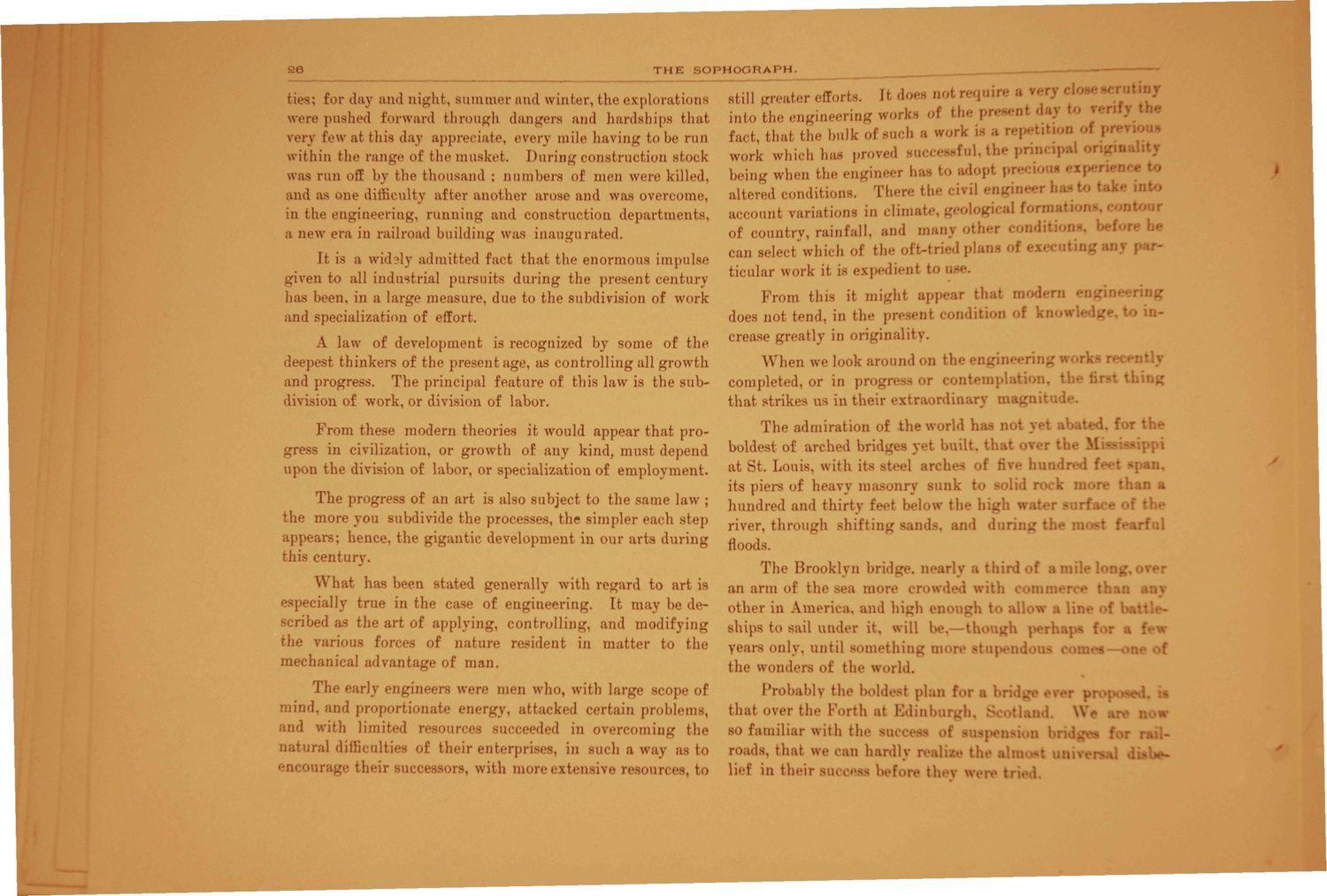| |
| |
Caption: Sophograph - 1890
This is a reduced-resolution page image for fast online browsing.

EXTRACTED TEXT FROM PAGE:
26 THE SC >HO< I H A l ' H . ties; for day and night, summer and winter, the explorations were pushed forward through dangers and hardships that very few at this day appreciate, every mile having to be run within the range of the musket. During construction stock was run off by the thousand ; numbers of men were killed. and as one difficulty after another arose and was overcome, in the engineering, running and construction departments, a new era in railroad building was inaugurated. It is a widdy admitted fact that the enormous impulse given to all industrial pursuits during the present century has been, in a large measure, due to the subdivision of work and specialization of effort. A law of development is recognized by some of the deepest thinkers of the present age, as controlling all growth and progress. The principal feature of this law is the subdivision of work, or division of labor. From these modern theories it would appear that progress in civilization, or growth of any kind, must depend upon the division of labor, or specialization of employment. The progress of an art is also subject to the same law ; he more you subdivide the processes, the simpler each step appears; hence, the gigantic development in our arts during his century. What has been stated generally with regard to art is ially true in the case of engineering. It may be decribed as the art of applying, controlling, and modifying the various forces of nature resident in matter to the mechanical advantage of man. Th arly engineers were men who, with large scope of iind. and proportiona energy, attacked certain problems, and with limited n >urC6fl succeeded in overcoming th natural difficultii of their enterprises, in such a way as to Bfcill greater efforts, fl doe. not require • intotl ngineeringwork. 01 the ,.r-.n fact, that tlio bulk of tcbaworki itwi work whirl, hae proved »uw.-«fiil.tta principal being when the engineer hi I" »«1 altered condition* There th« dvil engineer h I account variations in rlnnat ological foni he J of country, rainfall, and many other ndii can select which of the oft-tried plans of nting ticular work it is expedient to use. From this it might aj.j does not tend, in the present crease greatly in originality. ndi? > kr f DgilM ledgf -r in parg When we look around on the •< neering • completed, or in progress or o n tempi u I that strikes us in their extraordinary n The admiration of 4heworld has n I tab boldest of arched bridges re. built th rer i M.-—at St. Louis, with it itee] arches of rive hundred fe its piers of heavy ma nrv sunk to soli I rock i e than hundred and thirty feel belou he high wiv nrfaee river, through shift ing sands, and d u r i n g wt fearful floods. The Brooklyn bridge, nearly a third of a mil» an arm of the i more crowded with eoinr •• other in America, and high • ugh to allow a linships to sail under it. will be,—though perhaps years only, until BOmething moi - I pen the wonders of the world. 8 I ba* a few Probably the bold, plan for a 1 that over the Forth at Edinburgh, so familiar with the 8Q 668 of roads, that wi an hardly real almost lief in their > before th< uviv ; > r p aosed « \\ ridges f rsal "/ rurage theii , with more extensive resources, to
| |